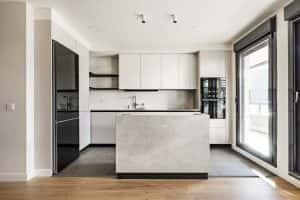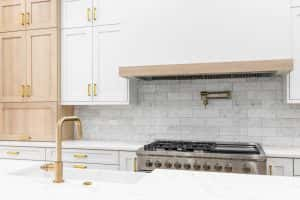 Modular kitchens are sleek, functional and cost-effective. They are also stunningly beautiful; all the reasons why most homeowners today have these kitchens on top of their must-have list for their home interiors!
Modular kitchens are sleek, functional and cost-effective. They are also stunningly beautiful; all the reasons why most homeowners today have these kitchens on top of their must-have list for their home interiors!
If you’ve decided to go down the modular kitchen route, but don’t have a clue where to begin—not to worry! We’ve got you covered, with this handy primer on how you can select the best modular kitchen cabinets and hardware for your space.
Read on for the lowdown on each material, pro tips and more.
Find the Perfect Match for your Modular Kitchen
Whether you’re working on updating your kitchen or doing it up from scratch (how exciting is that!), a modular kitchen is the way to go if you want to stay trendy. For a cohesive look, you must match the look and feel of your kitchen décor to the rest of your home — whether it’s classical, transitional or contemporary!

When you’re making your interior decisions, you’ll need to choose the materials with care. Your choices will not only transform the look of your space, they will also impact its longevity and functionality. Here’s some expert advice on choosing cabinets and hardware that go well together and meet your needs.
Modular Kitchen Cabinet Materials

Your kitchen has to cope with high temperatures and humidity, the possibility of stains and spills, and perhaps rough handling by maids and cooks. The materials you choose for the core of the cabinets should be sturdy enough to withstand all these stressors, and should last a good many years without breaking down.
Here are some of the most common modular kitchen cabinet materials, and the pros and cons of each!
MDF or Medium Density Fibreboard:
This is an engineered wood that is made by binding together wood residuals, combining with binders, and compressing into boards under high temperatures and pressures. MDF is stronger than particle board but less sturdy than plywood or real wood.
Pros: Affordable, smooth finish, resistant to warping, easy to work with.
Cons: Not water-resistant, so all the edges must be sealed well for durability.
Plywood:
Plywood is made of thin layers (called plies) of wood that are glued together, with the direction of the grains in adjacent layers at 90 degrees to each other. Marine plywood is boiling waterproof and can withstand continuous moisture without warping, making it well suited to use in the kitchen and in bathrooms. Commercial plywood has less resistance to moisture and is suitable for use in bedrooms and living rooms.
Pros: Strong, resistant to moisture, less prone to warping than MDF. Thin thicknesses of plywood can be bent without breaking.
Cons: Costlier than MDF, outer layers may splinter.
Particle board or Chipboard:
The most cost-effective option, particle board is manufactured from wood chips (particles) and extruded into a board using binders or resins. Different grades are available, with higher densities being stronger.
Pros: Inexpensive, smooth finish, very easy to work with.
Cons: Prone to damage from moisture, not as durable as plywood or solid wood. Has to be sealed and finished well on all exposed sides to protect from moisture, if used in the kitchen.
Modular Kitchen Countertop Materials
When choosing your kitchen countertop materials, there are a few important considerations that you must keep in mind.
- Your countertop should be non porous and resistant to stains and spills.
- It should also be durable and easy to clean.
- It’s always best if you remember to use a trivet when putting down hot pots, but in the event that you neglect to do so, the countertop should not be easily burned or damaged when exposed to heat.
- Some natural stones like marble may require periodic sealing to maintain their integrity, while others, like quartz and granite, are relatively low-maintenance.
Pro tip: Marble is a soft, porous stone, and gets discoloured with lime, turmeric and vinegar spills. Always wipe immediately to avoid staining.
- Marble and quartz are usually more expensive than granite, but there are some granite varieties with rare colours and patterns that could cost you an arm and a leg!
Pro tip: The most cost-effective material is black granite.
- Choose the colours and patterns that go well with your décor theme and colour palette.

Here are the most common countertop materials:
Granite:
A widely available natural stone, granite is durable and resistant to scratches, making it a popular choice for kitchen countertops.
Pros: Durable, cost-effective except for rare colours, heat-resistant, natural beauty, wide variety.
Cons: No cons as such!
Quartz:
Quartz, an engineered stone, combines beauty with practicality, offering a non-porous surface that is resistant to stains and scratches, and requires minimal maintenance.
Pros: Low maintenance, non-porous, wide variety of colours and patterns.
Cons: Can be costly, not completely heat-resistant.
Marble:
The preferred choice of the elite, marble oozes sophistication with its high-gloss, luxe appearance. It does, however, require maintenance to maintain its good looks!
Pros: Elegant appearance, unique veining, heat-resistant.
Cons: Porous, requires sealing, susceptible to stains and scratches.
Solid Surface (e.g., Corian):
Solid surfaces like Corian offer a seamless countertop option. Made of acrylic resin, Corian is stain proof, comes in a stunning variety of colours and patterns, and is very easy to maintain.
Pros: Seamless appearance, repairable, variety of colours and patterns.
Cons: On the expensive side, can scratch and scorch, not as heat-resistant as stone.
Modular Kitchen Door Materials

Cabinet doors are most commonly made of particle board or MDF, which are lightweight and easy to handle. The finishes (which could be of laminate, acrylic, membrane and so on) should complement your décor theme and match the overall aesthetic.
Glass-fronted-doors with sleek aluminium frames create a sense of transparency and openness, and are a great option for a minimalistic kitchen.
Aluminium rolling doors, usually used in appliance garages, offer a space-saving and modern solution that helps to tuck away bulky appliances out of sight.
Whatever may be the material you choose for the cabinet doors, do ensure that the edges are well sealed and perfectly finished, which will determine the durability and water resistance. Proper sealing helps prevent moisture infiltration, minimising the risk of warping, swelling, or other forms of damage over time.
Modular Kitchen Hardware Materials
The hardware you choose plays an all-important role in the functionality and aesthetics of your kitchen. Hardware can be of stainless steel, chrome, brass, aluminium, wood, ceramic and so on; and you should consider the specific function, décor theme and your budget while narrowing down your choices.

Hinges: Hinges are basic elements in modular kitchen design, which enable the smooth opening and closing of cabinet doors. They are most commonly made from materials like stainless steel, brass, or zinc alloy. Soft-close hinges are fitted with a mechanism that slows down the closing action, and adds convenience while reducing wear and tear.
Lift-Ups: Lift-up mechanisms offer easy access to overhead storage spaces without obstructing the workspace. These systems use pneumatic or mechanical assistance to lift the cabinet door, providing a hands-free solution to keep the shutter open while you work.
Heavy Duty Channels: Heavy-duty channels, as the name suggests, bear the weight of drawers used to store large utensils, pots, and pans. These channels enable drawers to slide smoothly and easily, even when heavily loaded. Soft-close heavy-duty channels, while a tad more expensive, prevent slamming, reduce noise, and extend the lifespan of the drawer mechanism.
Handles: Handles add a finishing touch to modular kitchen cabinets and drawers. Available in a diverse range of materials, styles, and finishes, handles add aesthetics and functionality, allowing you to open cabinets with ease. Handle-less, push-to-open options are also available which lend a sleek and streamlined look to modern kitchens.
Modular Kitchen Finish Selection Guide

The look of your kitchen depends on what’s on the outside – which is the cabinet finishes! Whether you go for a high-end aesthetic with acrylic, a modern vibe with laminate, or durability with PU and membrane finishes, each choice adds its own style to your kitchen. Think about factors like longevity, maintenance, and aesthetics to make sure your chosen finish makes your kitchen both stylish and enduring.
Modular Kitchen Finish Options
These are the most popular modular kitchen finishes:
Laminate:
Laminate doors are budget-friendly and come in a wide range of colours, textures and patterns. They are durable, resistant to stains, and can be easily wiped clean. This makes them the most practical choice for busy kitchens.
PU Finish:
Polyurethane (PU) finishes offer a luxe look, and are prized for their smooth, glossy appearance and durability. These finishes are applied as a liquid spray, creating a seamless and uniform surface.
Membrane:
Membrane finishes involve wrapping a PVC foil or membrane around MDF or particle board, applying heat and pressure to mould it seamlessly on the surface. They are available in many vibrant colours, patterns and textures, and are relatively more expensive than other finishes.
Acrylic:
Acrylic finishes for kitchen cabinet doors are known for their lovely high-gloss appearance and elegant designs. They are easy to clean, but may show fingerprints and also scratches more prominently, so will require a high level of maintenance.
Let’s Get Started on Crafting Your Dream Kitchen!
Ready to start bringing your dream kitchen to life? At HomeLane, we understand the magic that a well-designed kitchen can add to your home. Our design experts have what it takes to understand your vision and turn it into stunning reality, with the best materials and finishes that money can buy. Give us a call today!




